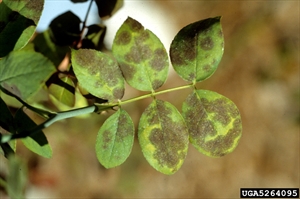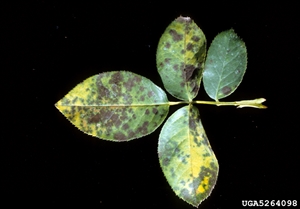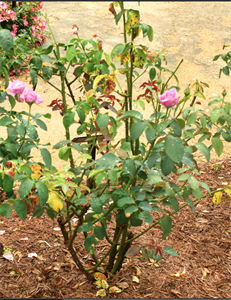Black spot of rose. It is also known as leaf blotch of roses.
Pacific Pests, Pathogens and Weeds - Online edition
Pacific Pests, Pathogens & Weeds
Rose black spot (388)
Diplocarpon rosae; this is the sexual name of the fungus. It is also known by its asexual state as Marssonia rosae.
Asia, Africa, North, South, and Central America, the Caribbean, Europe, Oceania. It is recorded from Australia, Fiji, New Caledonia, New Zealand, and Papua New Guinea.
Rose
A common fungal disease throughout the world, worst in warm (20-25°C) wet weather. Irregular black spots up to 10 mm diameter with feathery borders develop on the leaves especially the top surfaces, sometimes surrounded by yellow halos (Photos 1-3). The spots merge forming large black patches, and the leaves age early, turning yellow and fall (Photo 4) Spots also appear as dark purple or black spots on the young stems (called 'canes').
Spread of the fungus occurs as spores in wind-blown rain, and rain-splash. Usually, it is the lower leaves that are first infected and then the disease progresses upwards. The spores need to be in water for 6-7 hours to germinate and infect.
The fungus survives in a number of ways depending on weather conditions. In temperate areas it survives on fallen leaves or in infected canes left on the soil when roses are pruned to remove dead or weak growth. In the tropics, it survives dry times on leaves, stems and also bud scales remaining on the plants.
A serious disease of roses, with many susceptible varieties. The loss of leaves leads to a general weakening of the plant over time and progressively fewer flowers. Susceptible varieties may be defoliated entirely.
Look for the characteristic black spots, especially prominent on the upper surfaces of the leaves. Look for the yellow haloes around the spots, and leaves that fall prematurely. Look for spore-producing bodies in the spots using a hand-lens.
CULTUAL CONTROL
Before planting:
- When buying plants, or in your own nursery, always check if black spot is present, and avoid these plants.
During growth:
- Select a site for planting that is sunny, well-drained, with good air circulation, and space the plants 1-1.25 m apart, allowing air to move around and through them.
- Prune regularly to remove dead, weak or crowded stems to assist air circulation.
- Do not water over roses, always water the soil around the plants, otherwise you create conditions for spore spread and germination.
- Water in the morning so that any water settling on the leaves evaporates quickly.
- Feed roses a little and often to ensure that they are healthy and sturdy growth. Applications of sulphate of potash are recommended: 100-150 g per bush 3-4 times a year.
- If susceptible varieties must be grown, it is best to plant them together with more resistant kinds.
After flowering:
- Practice good hygiene: do not allow fallen leaves to remain on the soil; collect and burn them, and apply a mulch to stop water from splashing spores from leaves on the soil to the lower leaves on the plant.
- Prune or remove infected leaves from the plants before spraying with a fungicide.
RESISTANT VARIETIES
There are many rose species and hundreds of varieties, so obtain advice from nurseries, garden centres, or from growers' catalogues about tolerance or resistance to black spot before making a purchase. Many shrub and floribunda rose varieties have resistance.
CHEMICAL CONTROL
- For biorational options, use copper, lime sulphur, neem oil, potassium bicarbonate. Baking soda (sodium bicarbonate) can also be used: 1 teaspoon (5 ml) to 1L water, plus a drop of liquid soap. A formulation containing a bacterium, Bacillus subtilis, is available.
- For synthetic fungicides used in Australia choose from the following: (i) protectant fungicides - captan, chlorothalonil, mancozeb, mancozeb/sulfur, mancozeb/captan); (ii) systemic, curative or eradicant fungicides - bitertanol (triazole fungicide), difenoconazole (triazole fungicide), trifloxystrobin/tebuconazole (combined strobilurin and triazole fungicide).
- Note for systemic fungicides, carefully follow the manufacturers' directions, including the number of consecutive applications before changing to a fungicide belonging to a different class to avoid selection of resistant powdery mildew strains.
- Choose a dry, calm day to apply the products and reapply after a rain or every seven to 10 days for most effectiveness. Reduce or even stop spraying during dry weather.
____________________
When using a pesticide, always wear protective clothing and follow the instructions on the product label, such as dosage, timing of application, and pre-harvest interval. Recommendations will vary with the crop and system of cultivation. Expert advice on the most appropriate pesticide to use should always be sought from local agricultural authorities.
AUTHOR Grahame Jackson
Information from Ned Tisserat, Colorado State University. (https://wiki.bugwood.org/HPIPM:Diplocarpon_rosae); and Wikipedia. (https://en.wikipedia.org/wiki/Diplocarpon_rosae); and from CABI (2018) Diplocarpon rosae (black spot of roses). Crop Protection Compendium. (https://www.cabi.org/cpc/datasheet/19153). Photos 1&2 Florida Division of Plant Industry, Florida Department of Agriculture and Consumer Services, Bugwood.com.
Produced with support from the Australian Centre for International Agricultural Research under project HORT/2016/18: Responding to emerging pest and disease threats to horticulture in the Pacific islands, implemented by the University of Queensland and the Pacific Community.







